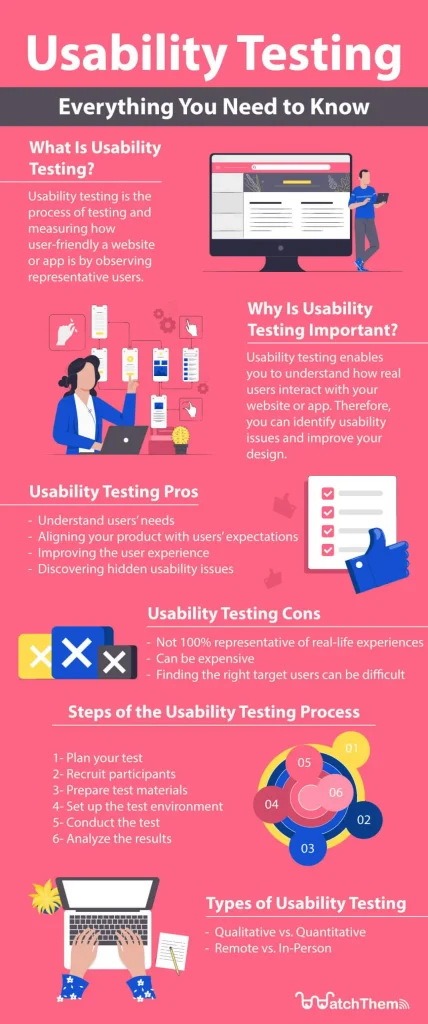In this usability testing infographic, you’ll find out all you need to know about this testing method. Here’s what you will learn:
- What is usability testing?
- Why is usability testing important?
- The pros and cons of usability testing
- Steps of the usability testing process
- Types of usability testing
Usability testing helps you evaluate how user-friendly your product or service is by testing it with real users. It involves asking participants to perform some tasks while researchers observe their behavior. The process enables you to understand how users experience the product so you can identify the problems they face and areas for improvement.
Conducting usability testing is necessary to figure out how to improve the user experience and fulfill users’ needs. Also, it’s an excellent way to discover the usability issues of a new product or service. So, when you start marketing this product or service, it will meet customers’ expectations.
As you can see in this usability testing infographic, although this testing method has many benefits, it has its own disadvantages. First of all, the test results don’t completely represent real user experiences. Furthermore, sometimes performing usability tests can be expensive depending on the method you are using. Another problem is that it’s not always easy to recruit a group of test users considering your product or service’s target market.
Now let’s take a look at the steps you need to follow in the usability testing process:
- Planning your test: Before starting the testing process, it’s crucial to define the purpose of your test, the user segment you want to test, and the questions you want to ask users.
- Recruiting participants: Recruit a group of users that represent your target audience.
- Preparing test materials: Prepare test materials to determine the actions you want users to perform.
- Designing your test environment: Set up the test environment you want to perform your tests (lab testing or remote testing.)
- Conducting the test: Now it’s time to perform your test.
- Analyzing the results: After conducting your tests, you should analyze the data you have collected to gain insights into improving your product or service.
There are two types of usability testing:
- Qualitative vs. quantitative: Qualitative usability testing involves gathering insights into how people use the product or service, while quantitative usability testing requires collecting metrics.
- Remote vs. in-person: In-person tests are performed in the physical presence of the testers, while remote tests are done through the internet or telephone.
Make sure to download this usability testing infographic and keep it for later.



